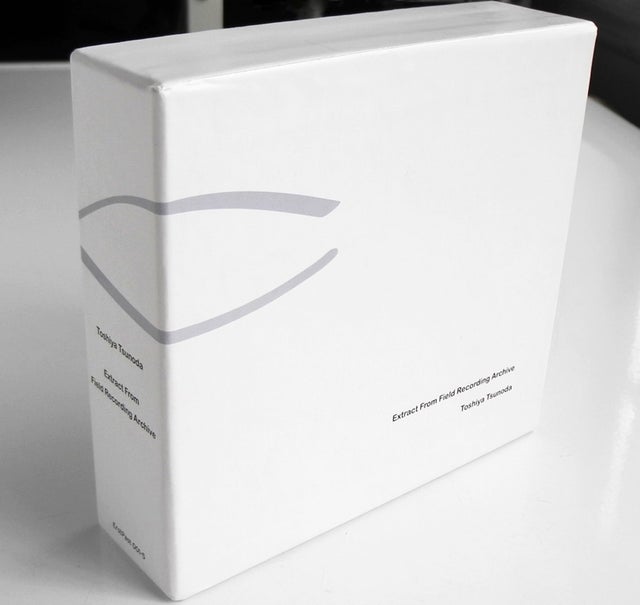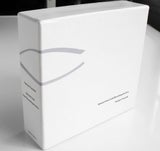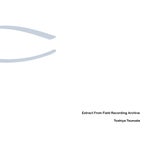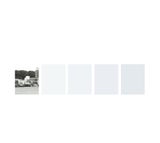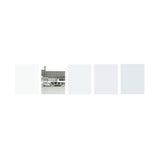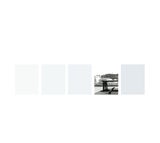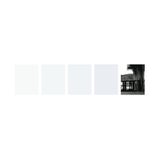- Toshiya Tsunoda
- >
- Toshiya Tsunoda - Extract From Field Recording Archive (5CD)
Toshiya Tsunoda - Extract From Field Recording Archive (5CD)
SKU:
$72.00
$72.00
Unavailable
per item
ErstPast 001-5
The box set holds five discs from Toshiya Tsunoda’s Extract from Field Recording Archive series. Disc 1-3 contain the first three albums from the series, all of which had been previously released between 1997-2001. Disc 4 contains unreleased material from that era, and Disc 5 contains more recent recordings from 2007-2018, in which he revisited some of the original port areas. The box set also includes a 44-page English/Japanese booklet containing liner notes by Toshiya Tsunoda (English translation by Yuko Zama) and photographs by Atsushi Tominaga.
Lossless digital (16/44) is available.
Sold out
|
TRACK LIST
DISC 1 : Extract From Field Recording Archive #1 - Vibrations In Stationary State Track 1: Solid vibration from the concrete pavement of a pier where the fish market used to be held Track 2: Solid vibration of a glass bottle in a ship anchorage Track 3: Air vibration of the hollow part in the middle of a navigation float Track 4: Air vibration in a bent pipe Track 5: Solid vibration of a steel plate in a loading area Track 6: Solid vibration of a support pillar for the external unit of a large refrigerator Track 7: Solid vibration of the surface of small breakwater Track 8: Air vibration of an elevator motor room in stairwell DISC 2: Extract From Field Recording Archive #2 - The Air Vibration Inside A Hollow Track 1: Bottle at mountain road Track 2: Bottle at park Track 3: Tub-type container Track 4: Drain hoses Track 5: Connecting duct Track 6: Downpipe for rainwater Track 7: Plastic float Track 8: Cavity in a cliff wall DISC 3: Extract From Field Recording Archive #3 - Solid Vibration Track 1: Metal plate fence Track 2: Wire net fence inside a tunnel Track 3: On the pavement of a pier, an electric screwdriver Track 4: On the pavement of a pier, two ships Track 5: Asphalt road surface Track 6: Metal door Track 7: Scrap Track 8: Gas cylinder, windy day (Takes 1&2) Track 9: Drum DISC 4: Extract From Field Recording Archive #4 - Stationary Wave Of Nagaura Port Track 1: Vibration from a water suction pump - Solid vibration Track 2: Gap between ship and pier - Air vibration Track 3: A simple fence, inside the iron pipe - Air vibration Track 4: Solid vibration, location unknown Track 5: Akebono Kikai Company - Air vibration Track 6: Inside a tower silo, short interruption - Air vibration Track 7: Surface of an external wall of the warehouse - Solid vibration Track 8: Solid vibration, location unknown Track 9: Running fence - Solid vibration Track 10: A pipe on the roadside - Air vibration DISC 5: Reflection-Revisiting Track 1: Vibration of the mooring rope of a fishing boat at anchor Track 2: Vibration through long and thick rope at seashore Track 3: Inside of a pipe at the seashore Track 4: A pipe and the water flow Track 5: Clapping echoing inside a pipe Track 6: A bottle at the breakwater #1 Track 7: A bottle at the breakwater #2 Track 8: Solid vibration from the concrete pavement of a pier where the fish market used to be held Track 9: Mooring line and road surface Track 10: Inside the former fish market Track 11: Solid vibration on the road surface near the exterior wall of the ice-making facility #1 Track 12: Solid vibration on the road surface near the exterior wall of the ice-making facility #2 Track 13: On the edge of the shore (released May 28, 2019) CREDITS
recorded and edited by Toshiya Tsunoda from 1993 - 2018 CD 1-3: remastered by Taku Unami and Toshiya Tsunoda with the assistance of Kosuke Numakura (Artes Publishing Inc.) CD 4: mastered by Taku Unami and Toshiya Tsunoda with the assistance of Makoto Oshiro CD 5: mastered by Taku Unami and Toshiya Tsunoda Japanese liner notes by Toshiya Tsunoda Japanese liner notes checked by Kosuke Numakura English translation of liner notes by Yuko Zama booklet edited and designed by Yuko Zama photography by Atsushi Tominaga design by Yuko Zama produced by Jon Abbey and Yuko Zama special thanks to: Johan Berthling, Klas Augustsson, Howard Stelzer, Giuseppe Ielasi, Alejandra Salinas, Aeron Bergman, Yuko Zama, and Jon Abbey p+c 2019 Erstwhile Records |
Toshiya Tsunoda is a Japanese sound artist whose quarter century of exploration into field recording has been a huge influence on many other great artists working in similar territory. His archival series of three themed sets of field recording studies, released on three different labels from 1997 to 2001, 'Extract From Field Recording Archive #1-#3”, lay the groundwork for so much of what followed, both from Tsunoda and many others.
All the sounds in the original three releases (#1-#3) were physical vibrations recorded in outdoor and indoor environments from 1993 to 1999, in the port service area in the Miura Peninsula where he was born and grew up, as well as at the neighbor ports. Also, CD 1-3 are not identical to the originally issued ones. Now all the tracks have exactly the same durations as Tsunoda's original DAT recordings. All the tracks were remastered from these original DAT recordings for this box set. Thus, the duration of each track and each CD are different from the previously released ones. Also, the track lists on Extract #2 (CD 2) and Extract #3 (CD 3) are slightly modified from the original releases, as detailed in the booklet. In addition to those three, for this reissue box Tsunoda compiled two new albums. CD 4, 'Extract From Field Recording Archive #4', contains his previously unpublished recordings of the Nagaura Port from the same period as #1-#3, and CD 5, 'Reflection-Revisiting', contains more recent recordings from 2007-2018, in which he revisited some of the original port areas, looking for a certain continuity between his ideas in the past and the present, while also discovering the differences between the two periods. "My purpose for these recordings in the nineties was to observe vibrations, and at the same time to find the observation point for each recording. For some very subtle, inaudible vibrations, a special method of observation such as installing a contact microphone inside a bottle or a particular observation point is required. It can be said that the object of the vibration and the act of observation are inseparable. I think that it is not really 'detection' or 'documenting', but is more likely closer to 'depiction'. The word 'depiction' has a nuance of both watching and portraying an object simultaneously." "By using small microphones and contact microphones, I tried to detect vibrations that were integrated with the presence of the place, like the vague images existing in the lowest layer of our perception. The space that could be observed in this way was quite different from how we perceive the actual place as a space." (from liner notes by Toshiya Tsunoda) The extensive liner notes were newly written by Toshiya Tsunoda for this box set. REVIEWS
Michele Palozzo, esoteros What has distinguished Toshiya Tsunoda’s research on natural sound for over twenty years now is the virtuous pursuit of a middle way between its pure documentation and its recomposition based on the same. In the art of field recording, in fact, two extremes can be identified by approximation: one more purely “ecological” or descriptive, to which, for example, the interventions of Chris Watson and Éric La Casa historically refer; another, instead, ascribable to the domain of abstract sound art, represented in particular by the numerous “untitled” suites of mature Francisco López, sequences and collages of sources whose appearance is drastically manipulated and distorted. In the middle, we were saying, are found Tsunoda’s recordings on the verge of microsound, as well those by American pioneer Alvin Lucier and by Steve Roden, which often cannot be attributed to the acoustic source that they reproduce, thus revealing an “ulterior” and potential world inside of the existing one, without ever practicing artifices apt to depart from it. The quintuple boxset Extract From Field Recording Archive, inaugural publication of Erstwhile‘s archival series ‘ErstPast’, is both a recovery and completion (at least to date) of the “sub-sonic” investigation work carried out by the Japanese experimenter since his debut. The first three of five volumes in progressive numbers – remastered together with the illustrious colleague Taku Unami – had already appeared years ago in as many catalogues: in 1997 with WrK, a self-produced, short-run label; in 1999 with Swedish label Häpna, open to many other types of musical hybridization; and in 2001 in an unrepeatable joint venture between Intransitive (USA) and Fringes (IT), renamed for the occasion in the contracted form Infringitive). The two remaining volumes, previously unpublished, are the parenthetical complements of the aforementioned three, as they present pieces dated between 1994 and 1995 (#4), therefore previous to the first published extracts, and finally a corpus of “reinterpretations” undertaken between 2007 and 2018 (#5), that is new inspections in the areas concerned by the early works from the nineties. As Tsunoda himself declared, behind his interventions there is no intent of scientific demonstration, as if they were empirical essays on sonology, but an instinctive curiosity in relation to the ecosystems and objects that surround and often intersect the territories marked by human action. Therefore they are primarily studies intended for personal use, tools of knowledge, deepening and decoding of many different acoustic realities which are not immediately accessible. In this sense, the use of a microphone placed inside a bottle does not represent the application of a filter aimed at distorting the sound delivery of the natural element, but rather of an echo chamber useful in capturing phenomena which otherwise we wouldn’t be aware of, compared by the artist to “the vague images existing in the lowest layer of our perception”. The precise descriptions that title the tracks are therefore essential to spatially locate the measurements and possibly make explicit their material identity, to then delve into the most recondite sound angles, harbingers of singular results directly deriving from their intrinsic ability to intercept and transmit certain frequency spectra. Tsunoda’s research opens up to many minute epiphanies, summarized if possible in a truly crucial one: the sphere of the inanimate – whether it is steel or concrete surfaces, pipes or fence nets – acquires a reflected life through sound, it unexpectedly becomes a window on far more extensive and detailed perspectives than those contingent on the relatively limited “framing” of the microphone. “The very little phenomena of vibrations are related with vast space. If a contact mike is set on a building wall, one can hear vibrations of far places and at the same time, one’s consciousness of space stretches to that place.” [from an interview with Yuko Zama, © 2007 p*dis] On several occasions, the acoustic detail thus projects us towards an entire panorama on the horizon, albeit inevitably partial and hinted at with blurred features. The port environment was the first and most recurrent field of investigation for Tsunoda, because of the possibility of spontaneous dialogue between the seabed, the quay above and the submerged parts of the ships. In fact the transmission of frequencies underwater returns to inspire him in the latest selection of extracts, which also involves the mooring ropes of fishing boats, together with further surveys on the asphalt and inside some pipes adjacent to the shore. The long journey ends with a complete emersion to the surface, and for ten minutes the stereophony makes room for the entire sound inventory of the port, in a long shot that from the placid seething of the sea on the shoreline reaches the echo of seagulls and a barking dog, while some cars pass quickly on the road, dissolving the illusion of a scenery exempt from historical time. Toshiya Tsunoda’s archive fills the gap towards an apparent practice of abstraction with the conquest of an “augmented” sound reality, offering pre-existing phenomenological instances the opportunity to manifest themselves more clearly to the human ear: an epistemological approach which, in the artist’s words, does not correspond properly to a ‘survey’ or ‘documentation’, but rather approximates the concept of ‘depiction’, a term that in itself summarizes the nuances of both ‘watching’ and ‘portraying’. Ultimately, what might appear to be an expressionistic interpretation of reality is nothing more than the manifestation of properties that already pertain to natural and anthropic elements – and to which only a few devotees dare to dedicate themselves with such a zealous passion. |
